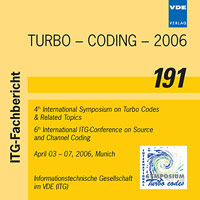A Novel Technique for the Evaluation of the Transfer Function of Parallel Concatenated Convolutional Codes
Conference: TURBO - CODING - 2006 - 4th International Symposium on Turbo Codes & Related Topics; 6th International ITG-Conference on Source and Channel Coding
04/03/2006 - 04/07/2006 at Munich, Germany
Proceedings: TURBO - CODING - 2006
Pages: 6Language: englishTyp: PDF
Personal VDE Members are entitled to a 10% discount on this title
Authors:
Chatzigeorgiou, Ioannis; Rodrigues, Miguel R. D.; Wassell, Ian J. (Computer Laboratory, University of Cambridge, UK)
Carrasco, Rolando (Dept. of EE&C Engineering,University of Newcastle upon Tyne, UK)
Abstract:
Turbo codes, in the form of parallel concatenated convolutional codes, consist of two recursive systematic convolutional encoders separated by an interleaver. Due to the presence of the interleaver, each constituent convolutional encoder accepts as input a block of information bits with a size equal to that of the interleaver rather than a continuous stream of information bits. By determining the transfer function of each terminated constituent convolutional code, which can be seen as a convolutional block code, an upper bound to the bit error rate performance of the turbo code is readily calculated. In this paper, we briefly present the conventional techniques for evaluating the transfer function of the convolutional block code and we propose a novel technique, according to which the state diagram of the convolutional code is modified so as to allow the direct evaluation of the transfer function of the convolutional block code.


